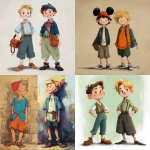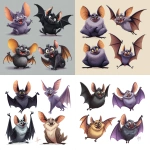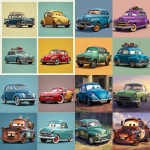Explore the Best AI Image Gallery

From Canvas to Code: Wearable Techs Revolution in the Creative Industry
The intersection of technology and creativity has always been a fertile ground for innovation. And today, wearable technology is pushing those boundaries further than ever before, revolutionizing how we create, experience, and interact with art and design.
From augmented reality (AR) glasses that superimpose digital elements onto the real world to haptic feedback suits that translate sound into physical sensations, wearable tech is providing artists and designers with a whole new set of tools to explore. This isnt just about novelty; its about fundamentally changing the creative process itself.
Wearable Tech: A Playground for Artistic Expression
Lets delve into some specific ways wearable technology is impacting the creative industry:
- Augmented Reality (AR) and Virtual Reality (VR): AR glasses allow artists to overlay digital elements onto their physical environment, creating interactive installations and immersive experiences. VR headsets transport viewers into entirely new worlds, enabling them to explore art in a completely different dimension.
- Gesture-Based Controls: Wearable sensors can detect and interpret hand gestures, allowing artists to control digital tools with unprecedented precision and fluidity. This opens up exciting possibilities for sculpting, painting, and animating in virtual spaces.
- Haptic Feedback: Suits equipped with haptic feedback technology can translate sound into physical sensations, allowing artists to experience music or sound design on a visceral level. Imagine feeling the rhythm of a drumbeat or the vibrations of a symphony orchestra through your entire body.
- Biometric Data as Art: Wearable sensors can capture biometric data such as heart rate, brain waves, and even skin temperature. Artists are using this data to create interactive artworks that respond to viewers emotions and physiological states, blurring the lines between technology and human experience.
Beyond the Tools: Ethical Considerations
As with any powerful technology, wearable tech raises important ethical considerations for the creative industry:
- Data Privacy: Wearable devices collect vast amounts of personal data. Its crucial to ensure that this data is handled responsibly and ethically, with transparent consent mechanisms and robust security measures in place.
- Accessibility and Inclusivity: Wearable technology should be accessible to everyone, regardless of their physical abilities or socioeconomic status. Designers must consider the needs of diverse users and strive to create inclusive experiences.
- Authenticity and Originality: The ease with which wearable tech can generate and manipulate creative content raises questions about authenticity and originality. Its important to establish clear guidelines and ethical frameworks for the use of AI-powered tools in art creation.
Looking Ahead: The Future of Creative Wearables
The future of wearable technology in the creative industry is brimming with possibilities:
- Enhanced Collaboration: Wearable devices will enable artists and designers to collaborate seamlessly in virtual and augmented reality environments, breaking down geographical barriers and fostering new forms of creativity.
- Personalized Creative Experiences: Wearables will allow users to customize their creative experiences, tailoring artworks and designs to their individual preferences and tastes. Imagine creating your own personalized soundtrack or generating art based on your unique biometric data.
- Immersive Storytelling: Wearable technology will revolutionize storytelling, immersing audiences in interactive narratives that respond to their actions and choices. This could lead to entirely new genres of entertainment and artistic expression.
As wearable technology continues to evolve, its clear that the creative industry is on the cusp of a major transformation. The lines between artist, audience, and technology are blurring, creating exciting new opportunities for innovation, collaboration, and self-expression.



















](https://images.ai-img.art/thumbnails/150/485c8b1c747827bdc9a962f8a1919b3c259b18dd263b260208a1eae19fb85e07.webp)













](https://images.ai-img.art/thumbnails/150/8d1fe5a7a49cfc96747182431a853357913286d89258383caab2d3b4681afcb5.webp)
](https://images.ai-img.art/thumbnails/150/2fbd98ecfc425cfc1597779121e1c0305437067779e9c471eb64ff9615d5be98.webp)


](https://images.ai-img.art/thumbnails/150/3020b8c2b6d9be07e042357107af1de10deb274a41d2b0f332684ad4b532a702.webp)






](https://images.ai-img.art/thumbnails/150/5197af8969d850e2a43e141d41e482ccbceedebceb2a4caf9f098f943f9d1b0f.webp)
](https://images.ai-img.art/thumbnails/150/269414b0e541026702e9e67c67602c96162f37ff460a388b3b36314c8fc936dd.webp)



